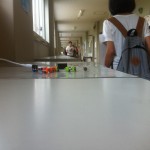Maker Toolset is back in action! We are at TIS for a new session of one of the popular clubs we have run there: The Electronic Arcade club. We kicked off the term with some personal introductions and an answer to, “What was the last thing you made?” We were excited to see that this group is very active in creating the world around them, whether it is from Legos, Minecraft, food or littleBits…this group is excited about making!
From there we moved on to an exploration of the basic rules of operation during the club. Top of the list was, “There are no bad ideas at first.” This led to a discussion about how we would like everyone to feel comfortable putting their ideas on the table without fear of judgment and then allow the opportunity for others to add to or improve. Everyone should help everyone make something great. We gave the class a short version of the D-School’s rules for Brainstorming (great rules for all ages!). I will put them in their original form below.
1. Defer Judgment. Don’t block someone else’s idea if you don’t like it…put it on the whiteboard and maybe you’ll be able to build on it later.
2. Go for volume. Getting to 100 ideas is better than 10, no matter what you initially think about the “quality”. Try setting a goal for the number of ideas you’ll get to in a certain amount of time to provide some stoke.
3. One conversation at a time. When different conversations are going on within a team, no one can focus.
4. Be visual. Sketch your ideas out for your teammate. It will communicate them more clearly than words alone, plus you might inspire some crazy new ideas.
5. Headline your idea. Make it quick and sharp, then move on to the next one.
6. Build on the Ideas of others. This leverages the perspectives of diverse teams and can be especially useful when you feel like you’re stuck.
7. Stay on topic. Your idea for an edible cell phone is awesome, but not during a brainstorm on making opera more exciting for children.
8. Encourage wild ideas. The crazier the better…you never know where your team might be able to take it. (See #1 and #6).
(From:http://dschool.stanford.edu/blog/2009/10/12/rules-for-brainstorming/)
Finally, we reviewed the anatomy of littleBits, which colours held what function and tackled our first design challenge. The resourcefulness and idea exchanges were awesome and we look forward to working with this group of young inventors. We also watched this video as inspiration for the kind of inventions that await. A great start to a great session.

































